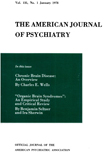Emergency Psychiatric Treatment During a Mass Rally: The March on Washington
Abstract
The authors present a rationale for establishing emergency psychiatric facilities during mass demonstrations. Special aspects or attributes such as trust, confidentiality, the authoritarian role of the physician, legal complications, the management of potentially violent patients, and the evaluation of thought processes are discussed. The low incidence of psychiatric casualties and the relative rarity of adverse drug reactions during the November 1969 March on Washington are documented: the majority of the most disturbed patients came to Washington for idiosyncratic reasons and did not regard themselves as antiwar protestors.
Access content
To read the fulltext, please use one of the options below to sign in or purchase access.- Personal login
- Institutional Login
- Sign in via OpenAthens
- Register for access
-
Please login/register if you wish to pair your device and check access availability.
Not a subscriber?
PsychiatryOnline subscription options offer access to the DSM-5 library, books, journals, CME, and patient resources. This all-in-one virtual library provides psychiatrists and mental health professionals with key resources for diagnosis, treatment, research, and professional development.
Need more help? PsychiatryOnline Customer Service may be reached by emailing [email protected] or by calling 800-368-5777 (in the U.S.) or 703-907-7322 (outside the U.S.).



